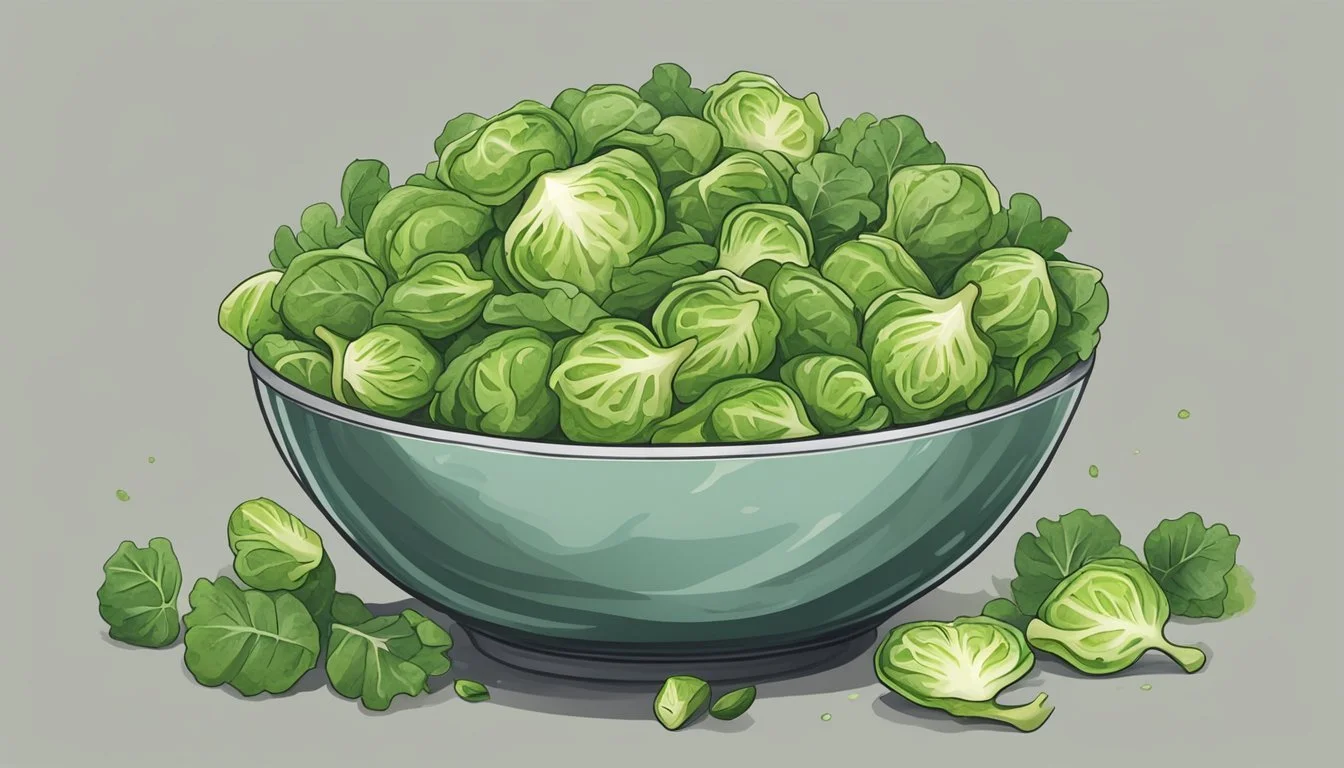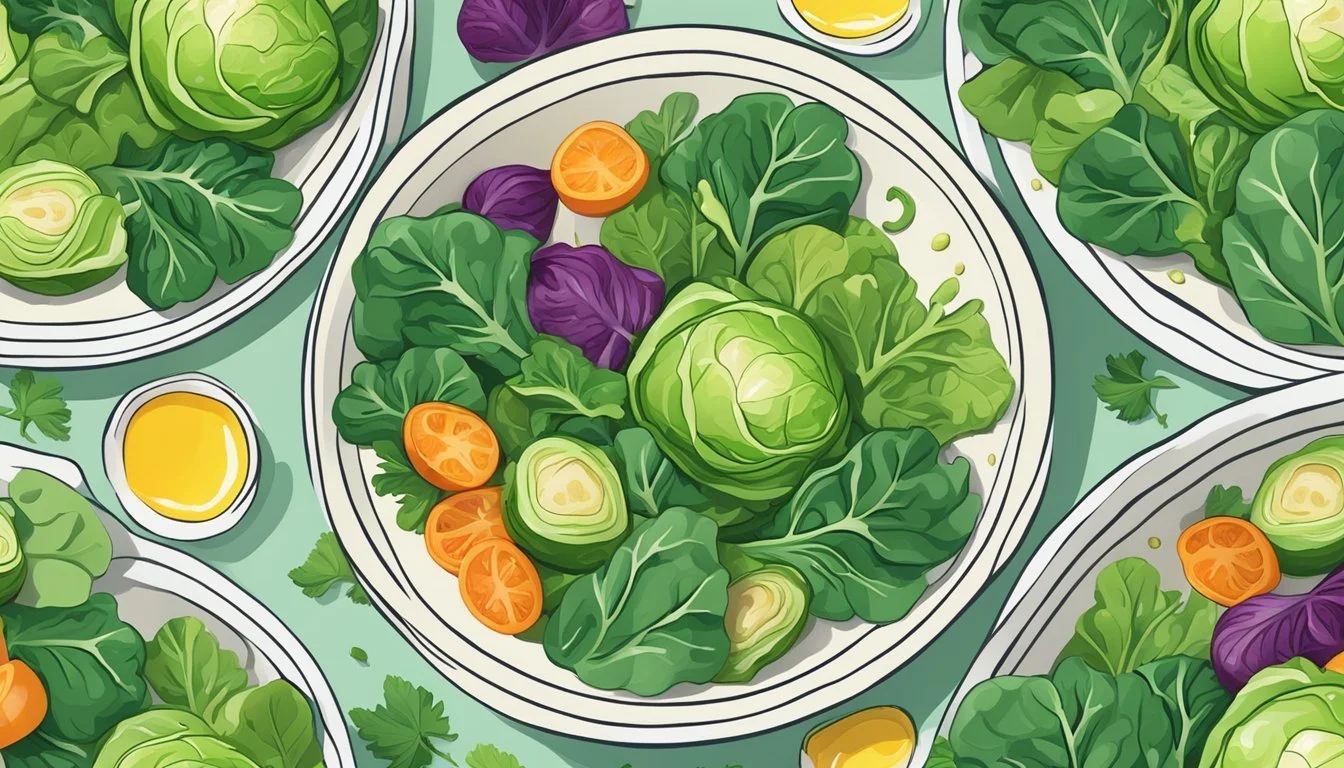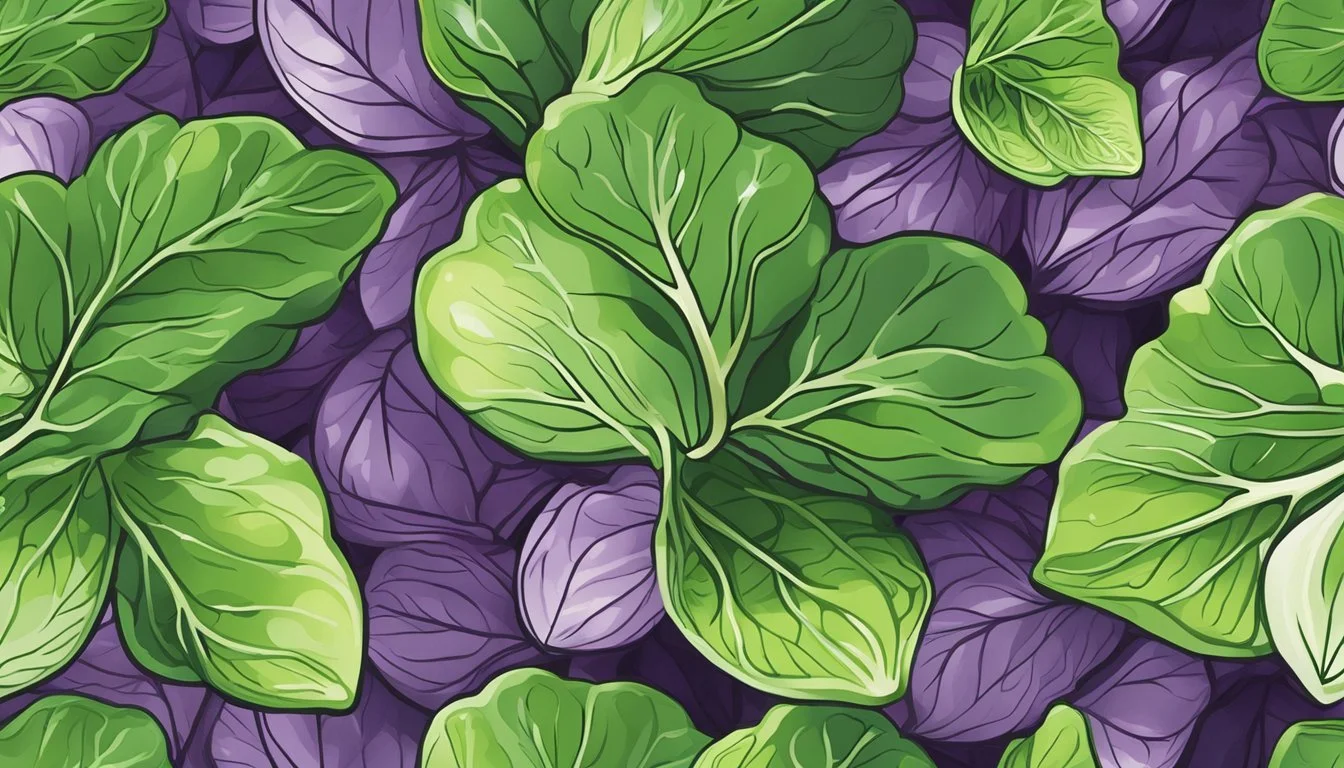Brussels Sprout Leaf Salad
A Tender, Flavorful Green That Elevates Your Meals
Brussels sprouts, a cruciferous vegetable similar to kale and cabbage, have steadily gained popularity amongst health-conscious eaters and culinary enthusiasts alike. Traditionally recognized for their appearance in roasted side dishes or as a complement to hearty meats, these vegetables are now taking center stage in the form of Brussels sprout leaf salad. This dish highlights the tender, yet slightly crunchy texture of the sprout leaves and offers a refreshing twist on the usual use of this nutritious green.
In a typical Brussels sprout salad, the leaves are separated from the core and either served raw or quickly blanched to enhance their vibrant color and reduce their natural bitterness. The versatility of Brussels sprouts allows for a range of seasonings and add-ins, making the salad a canvas for both bold and delicate flavors. With its rise in popularity, variations of Brussels sprout leaf salad can include an array of ingredients such as crisp bacon, sweet dried fruit, tangy cheese, or toasted nuts, each addition complementing the sprouts' robust flavor profile.
As an alternative to heavier salads (What wine goes well with salads?) , Brussels sprout leaf salad delivers a lighter, yet equally satisfying option. Rich in vitamins and nutrients, Brussels sprouts offer notable health benefits, making the salad not only a flavorful choice but a nutritious one as well. Whether tossed with a simple vinaigrette or a more complex dressing, the resulting dish is a testament to the versatility and enduring appeal of these miniature cabbages.
Health Benefits
Brussels sprout leaves, the tender greens of the Brussels sprout plant, offer a cornucopia of health benefits due to their rich nutrient profile. These leaves are not only flavorful but also packed with essential vitamins and valuable nutrients.
Nutrient-Rich: Brussels sprout leaves are particularly high in vitamin K, which is crucial for blood clotting and bone health. They also provide a good dose of vitamin C, an antioxidant that supports the immune system and skin health.
High in Fiber: Adding Brussels sprout leaves to a salad can increase dietary fiber intake. Fiber is important for digestive health, helping to maintain regular bowel movements and may contribute to a feeling of fullness, which is beneficial for weight management.
Nutrients in Brussels Sprout Leaves Benefits Vitamin K Aids in bone health and blood clotting Vitamin C Supports immune function and skin health Fiber Promotes digestive health and satiety
These leaves are also a source of other essential vitamins, such as A and B vitamins, contributing to overall energy levels and proper nerve function. Additionally, they contain nutrients like potassium, which is vital for maintaining healthy blood pressure and muscle function.
With their antioxidants, Brussels sprout leaves help protect cells from damage. The leaves also contain compounds that may offer anti-inflammatory properties, further supporting the body's health. Including Brussels sprout leaves into salads is not only a way to enjoy a fresh, flavorful green but also a choice that supports a nutrient-rich diet.
Choosing Ingredients
Careful selection of high-quality ingredients is crucial for creating a Brussels sprout leaf salad that is both tender and flavorful. From the freshness of the greens to the zestiness of the dressing, each component contributes to the overall taste.
Selecting Brussels Sprouts
For the foundation of the salad, one should look for fresh, bright green Brussels sprouts. They should be firm to the touch with tightly packed leaves. A food processor with a shredding attachment can make quick work of preparing the sprouts, but a sharp knife or a mandoline slicer is also adequate for thinly slicing them.
Salad Additions
When considering additions to the salad, variety and balance are key. Offer sweet elements like dried cranberries or apple slices, and nuts such as pecans or walnuts for a satisfying crunch. Tart elements like pomegranate seeds or cherries can also complement the flavor profile.
Dressing Components
A balanced dressing is essential for enhancing the salad without overwhelming it. Start with a high-quality olive oil as the base, add apple cider vinegar or lemon juice for acidity, and incorporate Dijon mustard or honey for complexity. Salt and pepper are fundamental for seasoning.
3 parts olive oil
1 part vinegar or lemon juice
Salt and pepper to taste
Optional: honey or mustard for emulsifying
Protein Pairings
Proteins act as a cornerstone for a more substantial salad. Grilled chicken or salmon provide lean options, while bacon can offer a rich smokiness. The protein should be well-seasoned and cooked just until done to maintain tenderness and moisture.
Cheese Varieties
Cheese adds a creamy or salty counterpoint to the salad. Crumbled feta or goat cheese offer a creamy tang, while aged cheeses (What wine goes well with aged cheeses?) like Parmesan, Pecorino Romano, or blue cheese bring a sharper depth. Use cheese sparingly and opt for freshly crumbled or shaved varieties for the best texture and distribution of flavor.
Preparation Techniques
When preparing a Brussels sprout leaf salad, proper techniques can significantly enhance the tender greens' natural flavors. From cleaning to creating a balanced vinaigrette, each step plays a crucial role.
Cleaning and Trimming
Before starting, clean the Brussels sprouts by removing the outer leaves and washing them in cold water. Trimming is just as important; cut off the stem ends and any discolored spots to ensure that all parts of the sprouts are fresh and edible.
Slicing and Shaving
For a delicate texture, slice the Brussels sprouts thinly using a sharp knife or a mandoline, which provides uniformity. Shaving the Brussels sprouts—either by hand or with a food processor—breaks them down into fine pieces that are ideal for a light, refreshing salad.
Roasting Methods
Roasting brings out a sweet, nutty flavor in Brussels sprouts. Toss them with olive oil, kosher salt, and pepper, and spread them on a baking sheet. For an airier texture, halve them before roasting. Cook in an oven preheated to 425ºF until they are golden and caramelized, about 20 to 25 minutes.
Assembling the Salad
After the Brussels sprouts are prepped and roasted, it's time to assemble the salad. Mix the roasted sprouts with complementary ingredients such as thin slices of apple, pomegranate seeds, red onion, and a selection of nuts like almonds, walnuts, or pecans, which add a satisfying crunch.
Creating the Perfect Balance
A harmonious vinaigrette is key to bringing together the flavors of the salad. Whisk together olive oil, acid such as lemon juice or vinegar, a sweet element like maple syrup, and season with salt and pepper. Drizzle the dressing over the salad and toss gently to coat every leaf for a perfect balance of sweet and savory.
Variations and Twists
Exploring a variety of ingredients can transform a simple Brussels sprout leaf salad into a versatile dish that caters to diverse palates and dietary needs. Each subsection presents specific options to modify the classic recipe.
Alternative Greens
Incorporating alternative greens such as spinach, baby arugula, or cabbage can add new flavors and textures to the salad. For a fall-inspired variation, one might mix in tender lettuce leaves or the bold bite of arugula.
Seasonal Flavors
To embrace the essence of autumn, adding slices of honeycrisp apple and pomegranate seeds can lend a sweet and tart flavor profile. Adapting the salad with seasonal ingredients not only elevates the taste but also ensures the use of fresh, available produce.
Texture Enhancers
For an added crunch, incorporating nuts such as candied pecans or seeds, along with quinoa, creates a multi-textured experience. These ingredients not only enhance the mouthfeel but also contribute beneficial nutrients.
Crunch Enhancers Benefits Nuts (Pecans) Rich in healthy fats and proteins Seeds Source of fiber and vitamins Quinoa Gluten-free and high in protein
International Inspirations
Exploring global cuisines can lead to innovative fusion salads. For instance, adding nuts traditional to Middle Eastern dishes, or using Asian-inspired dressings, can bring an international twist to the table.
Dietary Accommodations
One can easily adjust the salad to suit various dietary restrictions. By opting for vegan cheese or dressings, and ensuring ingredients like quinoa are used instead of gluten-containing grains, the salad becomes accessible to those following vegetarian, vegan, and gluten-free diets.
Serving Suggestions
When serving Brussels sprout leaf salad, one has the opportunity to transform this humble side into the star of any dining experience. The right accompaniments, plating techniques, and recipe pairings can enhance the dish's flavors and presentation, while proper storage ensures leftovers can be enjoyed later.
Accompaniments
To complement the tender leaves of the Brussels sprouts salad, consider adding a variety of textures and flavors. Crispy bacon bits or pancetta add a savory crunch, while toasted nuts like almonds or pecans offer an earthy note. Sweet elements like dried cranberries or diced apples can provide balance. For a burst of freshness, sprinkle finely chopped herbs such as parsley or chives just before serving.
Savory: Crumbled bacon, toasted nuts
Sweet: Dried cranberries, apple pieces
Fresh: Chopped parsley, chives
Plating Techniques
When plating the salad, aim for a presentation that showcases its vibrant colors and ingredients. Use a large, flat dish to spread out the leaves, allowing the various elements of the salad to be visible. Garnishes like a drizzle of maple vinaigrette or a lemon wedge on the side can add visual appeal while hinting at the flavors within.
Dish Choice: Large, flat
Garnishing: Maple vinaigrette drizzle, lemon wedge
Recipe Pairings
While the Brussels sprouts salad can stand alone as a light main dish, it pairs well with roast meats or grilled fish for a heartier meal. For a potluck or multi-course dining situation, consider serving the salad as a side dish alongside pasta dishes, quiches, (What wine goes well with quiche?) or a cheese and charcuterie (What wine goes well with charcuterie?) board.
Main Dish: Roast meats, grilled fish
Side Dish: Pasta dishes, quiches
Leftovers
Storage and reuse of the salad should maintain its texture and flavor. Place any leftovers in an airtight container and refrigerate. To rejuvenate the salad the following day, a quick toss with an additional splash of dressing or a spritz of lemon juice can refresh the flavors before serving it as an easy side dish or compact meal.
Storage: Airtight container, refrigerated
Reuse: Add dressing, lemon juice spritz
Nutritional Information
Brussels sprouts are a powerhouse of nutrients with a profile that supports a balanced diet. They are especially high in fiber, vitamin C, and vitamin K. For individuals conscious about their calorie intake, Brussels sprouts offer a nutritious option with a low-calorie count.
Nutritional Breakdown for 1 Cup of Boiled Brussels Sprouts (Approximately 156g):
Calories: 56
Protein: 4g
Carbohydrates: 11g
Fiber: 4g, aiding in digestion and satiety
Sugars: 2.7g
Fat: 0.8g
Saturated Fat: 0.2g
Unsaturated Fat: 0.6g
Vitamin C: 97mg (over 100% of the Daily Value)
Vitamin K: 219µg (over 250% of the Daily Value)
Brussels sprouts provide a substantial amount of macronutrients and are particularly suitable for those managing their macronutrient consumption for diets such as low-carb, keto, or high-fiber regimens. Their fiber content promotes feelings of fullness, which can help manage appetite and support weight management efforts. The presence of antioxidants and high vitamin C content contributes to the body's immune defense and skin health.
With their versatility, Brussels sprouts can be included in diverse meal plans. They are a vegetable that works well for people aiming to eat a more plant-centric diet, where variety and nutrient density are essential. They can be steamed, roasted, or shredded to create a Brussels sprout leaf salad that retains the nutrients while offering a tasty and appealing dish.
History and Tradition
Brussels sprouts hail from the Mediterranean region, with early versions likely cultivated in Ancient Rome. Their more modern form was extensively cultivated in Belgium during the 16th century, from which they derived their name. As a traditional vegetable in Belgian cuisine, they were used in a variety of dishes and eventually spread throughout Europe and later to the United States.
In culinary history, Brussels sprouts have been traditionally known as a winter vegetable, with a peak season running from autumn to early spring. Historically, they were grown for their hardiness and ability to thrive in colder climates.
Culinary Integration:
Europe: Embraced in Britain during the World War I as a staple due to its nutrient content and ease of growth.
United States: Gained popularity in the late 20th century, with a resurgence as a gourmet food ingredient in salads and side dishes.
Belgians have traditionally served Brussels sprouts boiled or steamed, often accompanied by hearty meats or in stews. However, as appreciation for the vegetable's versatility grew, chefs began to explore other preparations, such as roasting and incorporating them into salads, which enhances their nutty flavor without the common bitterness associated with overcooking.
Contemporary culinary traditions have seen Brussels sprouts define a presence in salads, using their leaves for a delicate texture and their buds for a more robust feel. Their vibrant green color allows for visually appealing dishes, while their high adaptability enables the combination with various ingredients like nuts, bacon, and vinaigrette to enhance flavor profiles.
FAQs
Q: How long should one blanch Brussels sprout leaves? A: One should blanch Brussels sprout leaves until they are a vibrant green and just tender, typically for less than 2 minutes.
Q: Is it necessary to use ice water after blanching? A: Yes, immediately immerse the Brussels sprout leaves in ice water after blanching to halt the cooking process, ensuring they maintain their vibrant color and tender texture.
Q: What is the preferred method to dress a Brussels sprout leaf salad? A: For dressing, it is often recommended to whisk the ingredients, like olive oil, mustard, vinegar, salt, and pepper, together in a separate bowl before pouring over the salad to ensure even distribution.
Q: Can one roast Brussels sprouts for a salad? A: Yes, roasting Brussels sprouts at 425°F (218°C) until tender can add depth of flavor. Typically, this takes about 20 minutes.
Q: How can one ensure a flavorful Brussels sprout leaf salad? A: To ensure a flavorful salad, one should start with fresh Brussels sprout leaves, properly season the dressings, and balance the ingredients with complimentary flavors like feta cheese, nuts, or dried fruits.
Q: If the salad is overly bitter, what can be done to fix it? A: To counteract bitterness, adding a sweet component to the dressing, such as maple syrup or honey, can help. Additionally, ensure that the Brussels sprouts are not overcooked, as this can increase bitterness.







